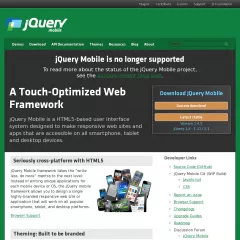jQuery Mobile 
jQuery Mobile is used by 0.20% of sites
Official Website
https://jquerymobile.comCategory
Mobile Frameworks
jQuery Mobile is a touch-optimized web framework that allows developers to create mobile-friendly websites and web applications. It is built on top of jQuery, a popular JavaScript library, and provides a unified set of user interface components and tools for building responsive and interactive mobile experiences. Here are some key aspects of jQuery Mobile:
Responsive Design: jQuery Mobile focuses on responsive design principles, allowing websites and web applications to adapt to different screen sizes and orientations. It provides a grid system and responsive CSS classes that enable developers to create layouts that automatically adjust based on the device's screen size.
Touch-Optimized UI Components: jQuery Mobile offers a wide range of touch-optimized user interface components, such as buttons, forms, navigation bars, collapsible panels, dialogs, sliders, and more. These components are designed to work seamlessly across different mobile devices and provide a consistent user experience.
Theme Framework: The framework includes a theming system that allows developers to customize the appearance of their mobile applications. It provides a set of predefined themes, icons, and color schemes, as well as options to create custom themes that match the branding and design requirements of the application.
AJAX Navigation: jQuery Mobile leverages AJAX navigation to enhance the performance and user experience of mobile web applications. It uses AJAX to load pages dynamically, reducing the need for full page refreshes and providing smooth transitions between different sections of the application.
Event Handling and Touch Gestures: The framework simplifies event handling for touch-based interactions on mobile devices. It provides abstractions for common touch gestures like swipe, tap, double tap, pinch, and rotate, making it easy to implement touch-based interactions in mobile applications.
Form Enhancement: jQuery Mobile enhances HTML forms by adding validation, styling, and AJAX form submissions. It provides validation options for form fields, automatically styles form elements to match the theme, and allows form submissions to be handled asynchronously using AJAX.
Accessibility: Accessibility is an important consideration in web development, and jQuery Mobile strives to provide accessible mobile experiences. It includes support for ARIA (Accessible Rich Internet Applications) attributes and follows best practices for creating accessible mobile applications.
Cross-Platform Compatibility: jQuery Mobile is designed to work across a wide range of mobile platforms, including iOS, Android, Windows Phone, and others. It aims to provide a consistent user experience and functionality across different devices and browsers.
jQuery Mobile simplifies the process of creating mobile-friendly websites and web applications by providing a set of ready-to-use components and tools. It is suitable for developers who want to build mobile interfaces that work well across different devices, leverage touch interactions, and provide a smooth and responsive user experience.
Responsive Design: jQuery Mobile focuses on responsive design principles, allowing websites and web applications to adapt to different screen sizes and orientations. It provides a grid system and responsive CSS classes that enable developers to create layouts that automatically adjust based on the device's screen size.
Touch-Optimized UI Components: jQuery Mobile offers a wide range of touch-optimized user interface components, such as buttons, forms, navigation bars, collapsible panels, dialogs, sliders, and more. These components are designed to work seamlessly across different mobile devices and provide a consistent user experience.
Theme Framework: The framework includes a theming system that allows developers to customize the appearance of their mobile applications. It provides a set of predefined themes, icons, and color schemes, as well as options to create custom themes that match the branding and design requirements of the application.
AJAX Navigation: jQuery Mobile leverages AJAX navigation to enhance the performance and user experience of mobile web applications. It uses AJAX to load pages dynamically, reducing the need for full page refreshes and providing smooth transitions between different sections of the application.
Event Handling and Touch Gestures: The framework simplifies event handling for touch-based interactions on mobile devices. It provides abstractions for common touch gestures like swipe, tap, double tap, pinch, and rotate, making it easy to implement touch-based interactions in mobile applications.
Form Enhancement: jQuery Mobile enhances HTML forms by adding validation, styling, and AJAX form submissions. It provides validation options for form fields, automatically styles form elements to match the theme, and allows form submissions to be handled asynchronously using AJAX.
Accessibility: Accessibility is an important consideration in web development, and jQuery Mobile strives to provide accessible mobile experiences. It includes support for ARIA (Accessible Rich Internet Applications) attributes and follows best practices for creating accessible mobile applications.
Cross-Platform Compatibility: jQuery Mobile is designed to work across a wide range of mobile platforms, including iOS, Android, Windows Phone, and others. It aims to provide a consistent user experience and functionality across different devices and browsers.
jQuery Mobile simplifies the process of creating mobile-friendly websites and web applications by providing a set of ready-to-use components and tools. It is suitable for developers who want to build mobile interfaces that work well across different devices, leverage touch interactions, and provide a smooth and responsive user experience.